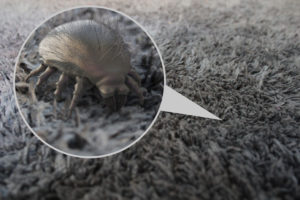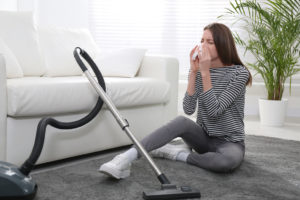Dust Mite Allergy Treatment & Prevention in Denver
Learn more about Dust Mite Allergies, including their symptoms, ways to prevent them, and how they can be treated at Advanced ENT & Allergy Center in Denver.
Dust Mite Allergies
Do you wake up stuffy year-round? You may be experiencing an allergic reaction to millions of microscopic critters who live in your bedding, furniture, and rugs. These are dust mites, and they live in homes all over the world.
Dust mites are the most common indoor allergen, affecting over 20 million people in the United States. These tiny bugs live in dust in your home, hidden in carpets and curtains, completely invisible to the naked eye.
While dust mites are invisible, they can cause an array of allergy symptoms, including sneezing, congestion, coughing, and even skin rashes. However, with some simple at-home steps and a treatment plan, you can kick these symptoms to the curb.

What is a Dust Mite?
Dust mites are miniscule, eight-legged pests — microscopic relatives of the spider that measure about one quarter to one third of a millimeter long. You can only see them under a microscope, but they can live anywhere in your home, most commonly hidden deep in the fibers of soft surfaces, like mattresses, pillows, carpets, furniture, and curtains.
Dust mites feed on shedded human skin cells that are deposited on your furniture, bedding, and carpets. One person can shed 1.5 grams of dead skin cells a day, which feeds up to one million dust mites at a time — so there’s always plenty of food for these pests!
Dust mites don’t have eyes and while they are sometimes confused with bed bugs, they aren’t actually parasites, so they don’t bite or sting. They can be found year-round, on every continent except Antarctica, thriving in temperatures of 68 to 77 degrees Fahrenheit and high humidity levels.
What is a Dust Mite Allergy?
Dust mites exist in even the cleanest of homes! That’s because most homes are ideal environments where dust mites can thrive, especially in bedrooms, where bedding, curtains, and carpets hold and trap moisture and dead skin particles.
But don’t be deceived — a dust mite allergy doesn’t mean you’re allergic to the bug itself. It’s actually the mites’ feces and decaying bodies that trigger allergy symptoms (yuck!). When you inhale these waste products, your immune system recognizes them as invaders, producing antibodies that cause the symptoms associated with allergies — sneezing, runny nose, coughing, etc.
– What Our Patients Say –
“I can finally breath! Thank you to everyone at Advanced ENT, you were amazing to work with, extremely organized and the most efficient Dr.’s office I have ever been to. ” -Noelle S.
Dust Mite Allergy Symptoms
While house dust can cause anyone to feel a tickle in their nose and trigger a sneeze attack, only certain people experience an immune response to dust mite particles that will provoke allergy symptoms. These symptoms can range from mild to severe and include:
- Runny nose
- Itchy skin
- Congestion
- Sneezing
- Coughing
- Postnasal drip
- Itchy eyes, nose, or throat
- Sinus pressure
- Fatigue
- Trouble breathing
If you have asthma, you may experience additional symptoms, including:
- Difficulty breathing
- Wheezing and shortness of breath
- Coughing
- Chest pain or tightness
- Difficulty talking
- Severe asthma attack
Dust mite allergies typically worsen at night and in the morning, due to proximity to bedding and pillows, where dust mites often live. While symptoms tend to be less severe than hay fever symptoms, dust mite allergies occur year-round and often intensify in the winter, when people are inside more.
 When to See a Doctor
When to See a Doctor
It can be difficult to determine if your allergy symptoms are a result of dust mites or simply a common cold, as symptoms are similar. However, if your symptoms last longer than a week, you may have an allergy.
Additionally, if your allergy symptoms seem to worsen when you are at home, especially when you go to bed or are cleaning, you should consider seeing a doctor. And if your symptoms are severe — congestion, wheezing, or difficulty sleeping — consult a doctor immediately.
How Does a Doctor Diagnose a Dust Mite Allergy?
An allergist can help determine if you are allergic to dust mites using a diagnostic allergy test. The most common test is called a scratch test (or skin-prick test), where your allergist will test an area of your skin with a small extract of allergen to see if you have an allergic reaction.
If you are allergic to dust mites, you will develop a bump around the area of skin tested with the dust mite allergen extract. The area may also become itchy and red. This response will appear within 15 minutes of the skin prick.
Other common types of allergy tests include intradermal, skin patch, and blood tests. All of these tests help uncover the underlying causes of your allergy symptoms in order to treat your allergies at their root.
How to Prevent Allergic Reactions to Dust Mites
The best treatment for dust mite allergies is to prevent and limit your exposure through eliminating as many dust mites in your home as possible. Some ways to reduce dust mites include:
- Clean your home regularly. While it’s impossible to completely rid your home of dust mites, keeping your home clean and clutter-free can significantly reduce the number of these pests.
- Protect your bedding. Keep your mattresses, box springs, comforters, and pillows inside zippered, dust-proof covers so dust mites can’t burrow in.
- Clean your bedding once a week. Wash everything (comforter, sheets, pillowcases) in hot water of at least 140 degrees Fahrenheit to kill dust mites and remove the allergens.
- Wash other dust mite habitats. This includes rugs, curtains, and stuffed toys.
Use a damp cloth or cleaning spray to remove dust weekly. - This helps prevent dust from floating into the air and resettling. Get rid of clutter, like excess decorations, books, newspapers, and other items to help reduce dust.
- Vacuum weekly. This includes your floors and your furniture. Using a vacuum cleaner with a HEPA filter or a double-layered microfilter bag can help trap allergens. If your allergies flare up while vacuuming or dusting, wear a mask or ask someone to do this chore for you.
- Replace heating and air conditioning filters regularly. We recommend every couple of months! You can also purchase a high-efficiency particulate air filter to help purify your home’s air.
- Use a dehumidifier. Dust mites like moist environments, so try to keep your home’s air below 50% humidity.
- Consider replacing furniture and carpets. Dust mites thrive in soft places. If your allergies are severe, you can consider replacing upholstered furniture with wood, vinyl, or leather. And consider replacing carpeted floors with wood, tile, linoleum, or vinyl.
Dust Mite Allergy Treatment
After you reduce the number of dust mites in your home, you may still experience allergy symptoms. Certain treatments and allergy medications may help reduce allergy symptoms:
- Nasal irrigation (like a neti pot) can help rinse irritants and mucus from the nasal passages and reduce nasal congestion.
- Antihistamines (like Claritin or Allegra) can help alleviate sneezing, congestion, and itchiness.
- Decongestants (like Sudafed or Afrin) can make it easier to breathe through the nose.
- Corticosteroid nasal sprays (like Flonase or Nasonex) can help relieve congestion in the nose.
- Prescription medications (like Accolate or Zyflo) may be necessary if symptoms are severe.
Treating Dust Mite Allergies With Immunotherapy
Many people with dust mite allergies find that prevention and medications aren’t enough because there’s no way to entirely eliminate or avoid dust mites (and there’s never seasonal relief from dust mites). For these patients, immunotherapy can offer long-term relief from dust mite allergies.
Allergen immunotherapy (allergy shots and allergy drops) works by gradually introducing your body to a specific allergen (through shots or through drops under the tongue). Over time, your immune system stops recognizing the allergen as an invader, decreasing and eventually eliminating your symptoms.
Sublingual immunotherapy, or allergy drops, has grown in popularity, as patients have experienced long-term relief from their allergy symptoms through this at-home, customized treatment process.
Get Help with Dust Mite Allergies
At Advanced ENT & Allergy Center, our allergy specialists have been treating patients with dust mite allergies for over 20 years. Our team will work with you to help uncover the causes of your allergy symptoms and provide a treatment plan that works for you. If you suspect you’re allergic to dust mites and want to experience relief, book a consultation today.
